Aside from my day-to-day tasks as a product manager, my big work project over the past year has been WARC’s new Future of Strategy report, which I conceived, researched and (finally) wrote. While it was a real passion project, it was also based on a big user need: the company’s hardcore fans are planners at ad and media agencies, yet within the marketing industry as a whole, the planning discipline is little-understood and often overlooked.
As a big planner resource, WARC should help them tell their stories. The basic idea behind the project was: every planner at an agency has their own personal view on the future of their discipline. And these views are frequently aired on Medium, LinkedIn, Twitter, at meetups and from conference stages. Wouldn’t it be good to put a bit of statistical heft on the topic: going beyond personal opinion?
This meant building a survey where we asked planners the same questions and aggregated the results. But I didn’t want to go too “quant” by sending an impersonal online form with some multiple choice questions – instead, I needed real, in-depth personal insights to go along with the data.
So the final Future of Strategy report was based on a global survey: phone, Skype and face-to-face interviews with 75 senior agency-side strategists, working around the world. It was a chance to shed some light on the current state of marketing strategy, and where the role might be going in future.
(Sidebar: if you’re confused by me using ‘planner’ and ‘strategist’ interchangeably, much more on this issue below.)
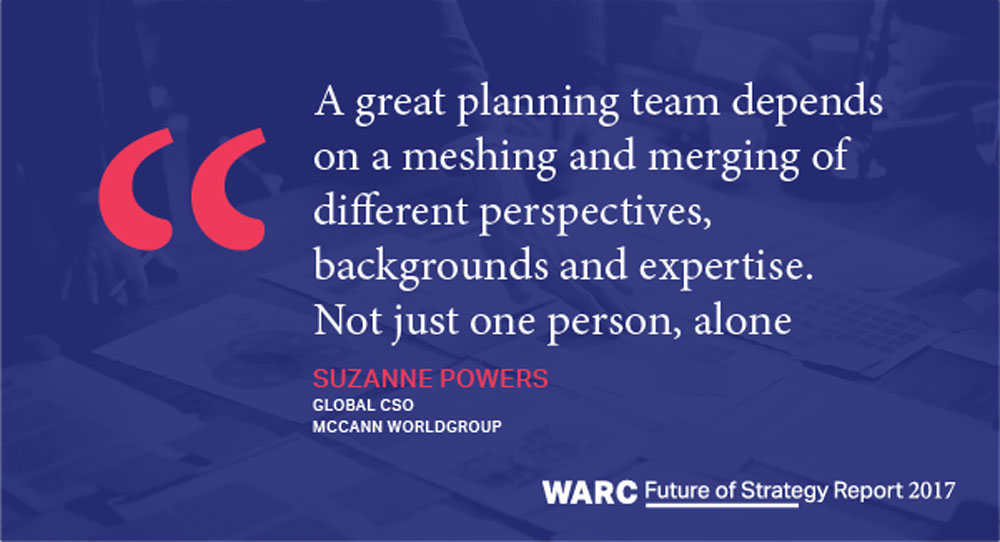
I also wanted to get views from across the spectrum: from creative, media and digital agencies; from Asia-Pacific, EMEA and the Americas (the survey was regionally balanced); and from heads of planning at individual agency offices, to people like Suzanne Powers, who heads up strategy at a global network with tens of thousands of employees.
So I needed to do what a good planner would do: get out there and talk to people. The setting for these talks ranged from the fancy – a balcony at the Palais des Festivals in Cannes – to the uncomfortable (I won’t miss those 5am Skype calls to Australia). Across all 75 of the interviews I conducted over the course of the survey, some surprising themes emerged.
Here are five of the big ones. (Of course, you can find many more in the final report.)
1) Consultancies are a big threat
Again and again, people treated the words “Deloitte”, “Accenture” and “McKinsey” like the name a horror movie monster: something scary, powerful and out for the traditional creative agency planner’s blood.
Some bemoaned the “brain drain” of bright graduates to these better-paying, more data-oriented companies. Others reflected that the analytical, business-oriented strategic services they offered were, in the words of one, “exactly what our clients want”. This was borne out by the survey’s finding that less than half (46%) of the survey felt the agency planner had become more influential among clients in the past year or two.
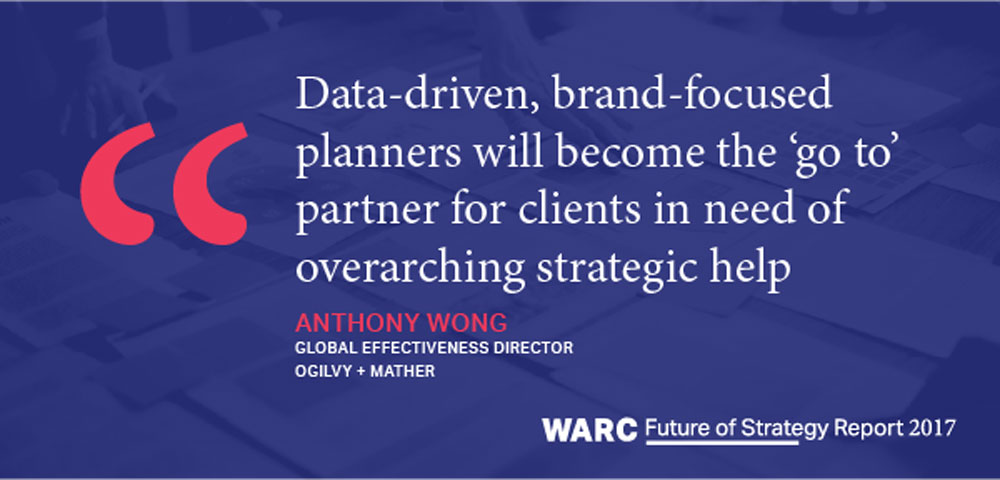
How can planners respond to changing client needs? For some, including Anthony Wong (quoted above), there’s a need for strategists to become more data savvy. Others pointed to agencies’ superior creativity, and suggested that the kind of great human insights offered by planners can’t be matched by a spreadsheet-wielding consultant.
2) Clients’ lack of time and cash is a bigger threat
But there’s a bigger monster out there than the scariest spreadsheet wielding Deloitte consultant: the brand manager. A really big finding from the survey was that 67% see “client pressures” as the single direst threat to their roles in future.
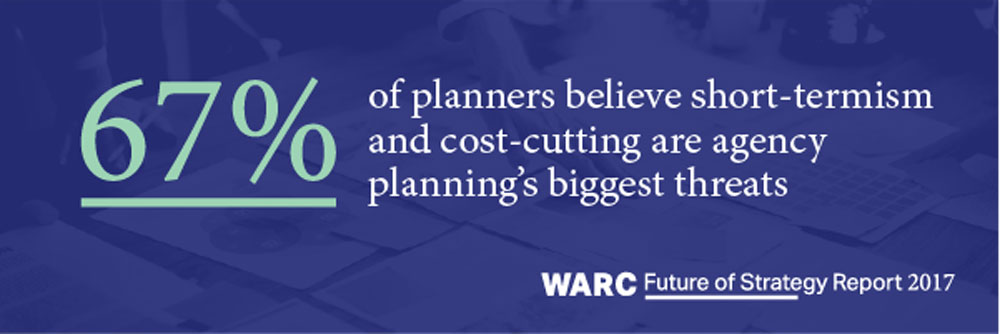
And these pressures come down to time and money. “Advertising used to be so relaxed!” complained one participant, pointing out that insight-hungry clients, high on the “real-time marketing” Kool-aid, now demanded projects turned around in days rather than weeks.
Budgetary pressures are also causing ever-more problems, particularly for a discipline in which “strategy hours” were often thrown in for free. More than one old hand in the survey pointed out that planning was often the first thing to get cut from the budget. “I get the sense they are trying to procure their way out of strategy,” complained another.
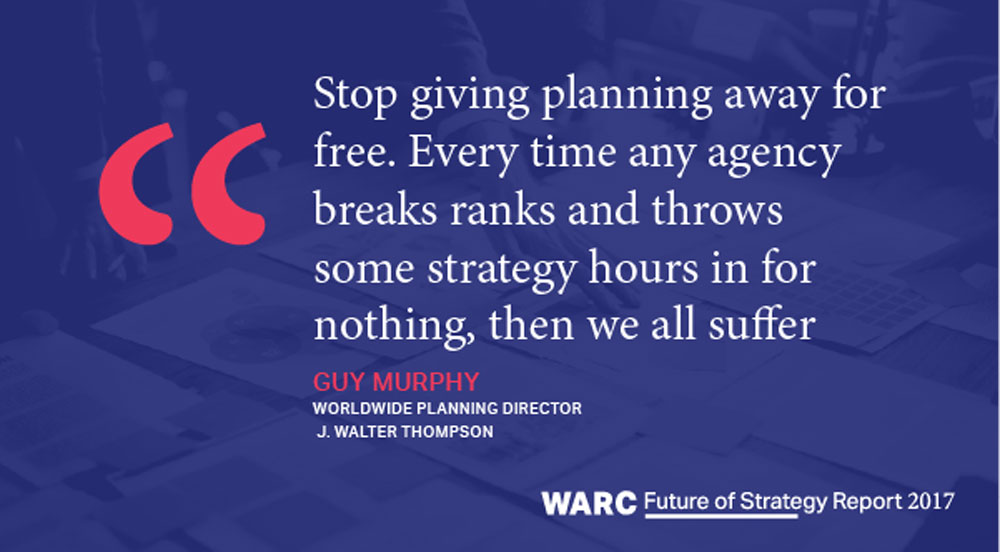
How do agencies respond to this pressure? Guy Murphy, for one, argues for them to get on the front foot, push back – and charge a fair rate for strategic services.
3) The agency’s seating plan is surprisingly important
Maybe the most unexpected, but vehemently-felt, disagreement that emerged from the interviews is the question of the agency’s seating plan.
Planners were split roughly 50/50 on whether they should sit with their fellow strategists, or in client teams with account managers and creatives. Both sides argued that their preferred arrangement was important for building a better “planning culture” at their agencies.
One CSO, who is in favour of integrated teams, pointed out that she saw planners and creatives making friends and going to lunch together when they had to sit together: an outcome that can only benefit the work. On the other hand, more than one participant pointed out that planners are generally outnumbered by other teams, and, if they sit together, feel less inhibited about bouncing ideas off their tablemates.

Though, while outnumbered, planner numbers are growing: around half of interviewees, including 53% at creative agencies, said their teams had increased in headcount in the past year.
4) Planners are strategists; strategists are planners
Some people in the role call themselves “planners”; some are “strategists”. One of the initial intentions behind the interviews was to tease out some of the differences in this terminology.
But it quickly became clear that there isn’t a meaningful difference: whether planner or strategist, their role is to look into the data, get an insight, and deliver a brief. While the job role of “strategist” – in terms of the number of people who use the word in their job title – is doubtless on the rise, and will continue to be thanks to the ever-widening range of strategic roles on offer in agencies, it’s still definitionally interchangable with that of the “planner”. So the two words are treated as synonymous in our final report.
And, whatever they’re called, they’re becoming more influential: 61% of planners/strategists said they have become more influential within their agencies in the past couple of years.
5) But, overall, the future’s bright
Despite the worries over definitions, consultancies, budgets and the seating plan, senior planners are seeing major opportunities in future.
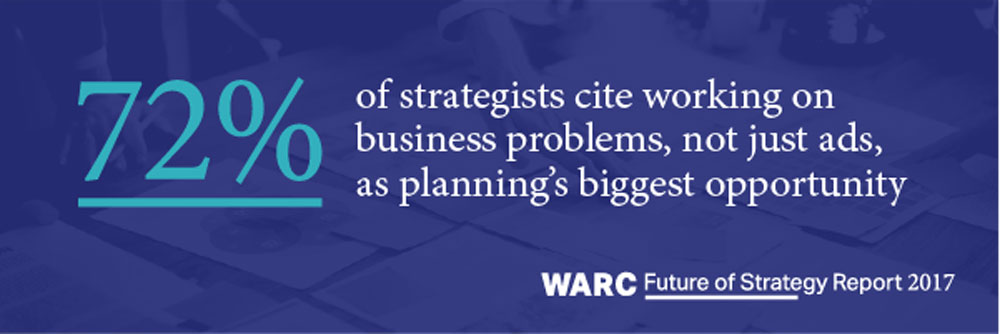
Almost three quarters (72%) identified one opportunity in particular as important for planning to increase its influence in future: going beyond solving communications problems to solving deep-lying business problems for clients. These problems could range from setting a brand purpose to advising on pricing. And there’s a shared sense that it’s in solving these problems that planners can best help clients.
“The agency’s services being more involved in business issues has given the planner a seat at the table that we simply didn’t have before,” said one head of planning. “Clients are searching for big, organising ideas – not tactical strategy,” said another.
‘Big picture’ strategy is here to stay, in other words. The planner’s role is to make a change in a client’s business, not just their advertising. Isn’t that what King and Pollitt were after all along? Maybe the future of strategy is still tightly linked to its past.
Anyway, project done. WARC subscribers can see the full Future of Strategy report, with full data, quotes and expert commentaries from 12 of the survey’s participants, here.